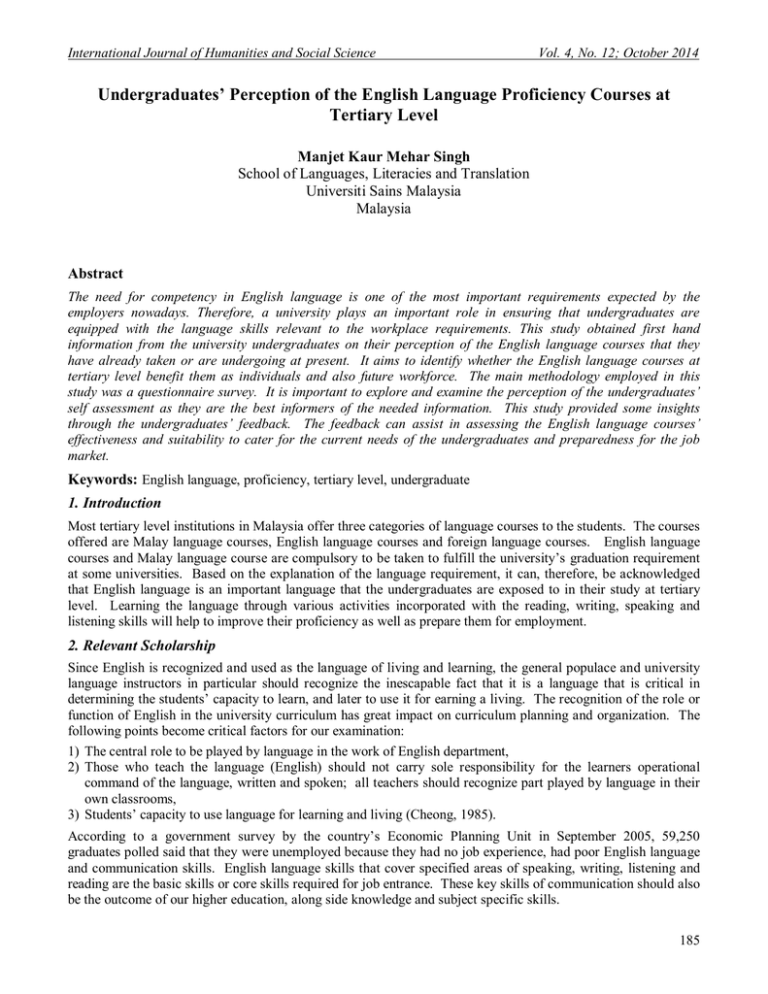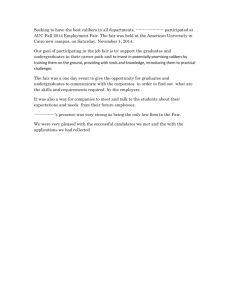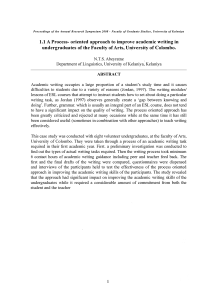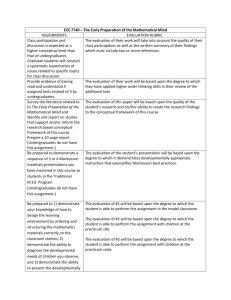Document 10466103
advertisement

International Journal of Humanities and Social Science Vol. 4, No. 12; October 2014 Undergraduates’ Perception of the English Language Proficiency Courses at Tertiary Level Manjet Kaur Mehar Singh School of Languages, Literacies and Translation Universiti Sains Malaysia Malaysia Abstract The need for competency in English language is one of the most important requirements expected by the employers nowadays. Therefore, a university plays an important role in ensuring that undergraduates are equipped with the language skills relevant to the workplace requirements. This study obtained first hand information from the university undergraduates on their perception of the English language courses that they have already taken or are undergoing at present. It aims to identify whether the English language courses at tertiary level benefit them as individuals and also future workforce. The main methodology employed in this study was a questionnaire survey. It is important to explore and examine the perception of the undergraduates’ self assessment as they are the best informers of the needed information. This study provided some insights through the undergraduates’ feedback. The feedback can assist in assessing the English language courses’ effectiveness and suitability to cater for the current needs of the undergraduates and preparedness for the job market. Keywords: English language, proficiency, tertiary level, undergraduate 1. Introduction Most tertiary level institutions in Malaysia offer three categories of language courses to the students. The courses offered are Malay language courses, English language courses and foreign language courses. English language courses and Malay language course are compulsory to be taken to fulfill the university’s graduation requirement at some universities. Based on the explanation of the language requirement, it can, therefore, be acknowledged that English language is an important language that the undergraduates are exposed to in their study at tertiary level. Learning the language through various activities incorporated with the reading, writing, speaking and listening skills will help to improve their proficiency as well as prepare them for employment. 2. Relevant Scholarship Since English is recognized and used as the language of living and learning, the general populace and university language instructors in particular should recognize the inescapable fact that it is a language that is critical in determining the students’ capacity to learn, and later to use it for earning a living. The recognition of the role or function of English in the university curriculum has great impact on curriculum planning and organization. The following points become critical factors for our examination: 1) The central role to be played by language in the work of English department, 2) Those who teach the language (English) should not carry sole responsibility for the learners operational command of the language, written and spoken; all teachers should recognize part played by language in their own classrooms, 3) Students’ capacity to use language for learning and living (Cheong, 1985). According to a government survey by the country’s Economic Planning Unit in September 2005, 59,250 graduates polled said that they were unemployed because they had no job experience, had poor English language and communication skills. English language skills that cover specified areas of speaking, writing, listening and reading are the basic skills or core skills required for job entrance. These key skills of communication should also be the outcome of our higher education, along side knowledge and subject specific skills. 185 © Center for Promoting Ideas, USA www.ijhssnet.com Furthermore, in an inaugural professorial lecture by Professor Ambigapathy Pandian (2006) it was indicated that English is the lingua franca of international commerce, science, engineering and technology. English has become a globally accepted language of communication and networking at present times. Further, it has been asserted that English is correlated with higher income and job productivity. Knowledge workers of the Information and Communication Age will not be able to participate effectively in global and local production of knowledge if they do not master the English language. English teaching and learning has experienced unprecedented growth and usage with the advent of new media technologies and global communication. As today’s process of teaching and learning changes, there are many aspects of the English language classroom that will have to undergo dramatic transformation. Students today are surrounded by information and opportunities that affect English language and what they learn and how they learn. All the developments stated above pose major challenges to teachers as the teaching and learning contexts change because of new technologies and increasing diversities of people (Pandian, 2006). Furthermore, in ensuring the Malaysian government’s support for the enhancement of English language proficiency and graduate employability, it has approved a new policy imposing that minimum pass in English language at tertiary level is compulsory for graduation purpose (Lee, 2014). This is to ensure the graduates are not only qualified in their field but also have the ability to communicate. 3. Focus of the Study The focus of the study is to investigate the undergraduates’ perception of the English language courses that are offered at a tertiary level institution in Malaysia. These undergraduates are currently undergoing English language courses at a public institution of higher learning in Malaysia. 4. Method This section will describe in detail how the study was conducted. 4.1 Participant Characteristics The participants in the study were 130 students (27 male and 103 female undergraduates) who were attending English language proficiency courses at a tertiary level institution for a particular academic session. These students, non-native speakers of English belonged to the age group of mainly 19-30 and were taking courses such as General English, Scientific and Medical English, Business and Communication English, Technical and Engineering English and lastly, English Pronunciation Skills. As for English language courses, the students have to acquire 4 units (2 courses) in order to fulfill the graduation requirement. Some English courses can be taken as skill courses or as options for further language improvement. Table 1: Age Group of Respondents Age Range (year) 19 20 - 21 22 - 25 26 - 30 Above 30 Number of Respondents 2 51 70 3 4 In terms of their race competition, there were 93 Malays, 30 Chinese, 3 Indians, 1 Punjabi, 1 Indonesian, 1 Kadazan and 1 Bajau. On the language often used, 93 used Malay, 30 Chinese, 3 Tamil, 7 English, 1 Bidayuh, 1 Suluk/Bajau, 1 Kadazan, 1 Indonesian and 1 Hindi. The samples for this study came from various schools such as Biology (11), Mathematics (2), Education Science (2), Physics (4), Management (4), Mass Communication (15), Education Arts (9), Special Education (10), Computer Science (17), Pharmacy (4), Translation and Interpretation (7), Social Science (19), Fine Arts (21), Humanities (3) and lastly English Language and Literature Studies (2). 4.2 Sampling Procedures Fourteen samples indicated that they obtained Band 1, 33 Band 2 and 42 Band 3 in their Malaysian University Entrance Test (MUET). As for the others, 14 samples obtained Band 4 and 14 obtained Band 5. Band 1 indicates the lowest level of English language proficiency and Band 6 indicates the highest level of English language proficiency. The number of samples with MUET result is less than the total number of samples as some samples did not indicate the results and some students did not have the MUET qualification. 186 International Journal of Humanities and Social Science Vol. 4, No. 12; October 2014 4.3 Research Design The main methodology used in the research was a survey questionnaire. The questionnaire in this research was designed by the researcher based on literature review in the field and written in English. The questionnaire was divided into four sections, mainly being personal details, attitudes toward English, self-assessment and lastly, learning of English. 5. Results 5.1 Attitude toward English Based on the feedback from the samples, 70.8% agreed completely in attending the English language courses which are required for graduation and only 2.3% did not agree at all. On the issue of interest in attending the other English language courses which are not compulsory for graduation, 27.7% agreed completely and a majority of 62.3% agreed only to some extent. We can note that the respondents showed a positive attitude towards attending the compulsory English language courses at the university. On the contrary, when questioned whether they would agree completely on attending the English language courses which are not compulsory only 27.7% agreed completely. 62.3% agreed to some extent. These findings indicate to us that majority of the respondents are motivated intrinsically to attend the English language courses. In terms of the samples’ belief, 96.9% of the sample believed that English is an important subject but only 74.6% agreed that English should be used as the medium of instruction at the tertiary level. It was quite surprising to note that 74.6% indicated that English should be made a compulsory subject that one has to pass in order to graduate. As to the interest of students in the English courses, only 53.8% requested that the university should increase the number of English language courses. In terms of the samples’ motivation level, 86.1% are motivated to improve their English language writing, speaking, reading and listening skills. 71.5% of the samples agreed completely that they need English language to attain a higher socio-economic standing in the community. Only 1.5% did not agree at all with this view. English language has a good ranking among the samples as 88.5% indicated that they need English to further their education, 67% indicated that English is important to get a job in the government sector, and 87.7% indicated that English is important to get a job in the private sector. The number of samples that stated that they would not be taking the English language courses if it was not compulsory for graduation is 22.3%. 67% stated that they will still be interested to take the English language courses even though the courses were not compulsory for graduation. Apart from that, 10.7% did not give any comments on this question. Once again we can note that external motivation exist to ensure these undergraduates undergo the minimum two courses equivalent to 4 units for graduation. On the other hand, we can also note that a high level of intrinsic motivation exist in the undergraduates for their self improvement and betterment. 5.2 Self Assessment Under this section, the samples were asked to rank the four skills in order of importance. Table 2: Ranking of the Importance of Language Skills Ranking Very important Important Not so important Not important at all Total Number of Respondents Reading Writing 60 60 45 50 12 13 13 7 130 130 Listening 66 48 9 7 130 Speaking 120 10 0 0 130 It is interesting to note that the most important skill is speaking. 92.3% indicated that it is the most important skill to be learned compared to the other skills. The undergraduates have voiced that speaking is one of the most important language skills that need to be mastered. However, the question that needs to be analyzed is the weakness of our graduates in their speaking skill. At present, the speaking skill ability is not as expected. 187 © Center for Promoting Ideas, USA www.ijhssnet.com 5.3 Learning of English 5.3.1 Objectives of the English Language Course This is the last section in the questionnaire and is divided into the objectives of the English Language Course, teaching methodology in the English Language Classroom, teaching and learning of English and lastly, teaching and learning material. 78.5% of the samples agreed that English language courses do help them to improve their English language proficiency. Apart from that, 65.4% said that English language courses help them in their study of other courses. In relationship with job preparation, 77.7% agreed completely that the English language courses help to equip them with the language skills required for job purpose. 5.3.2 Teaching Methodology in the English Language Classroom The findings of the study reflect teacher domination in terms of communication and talk time in the English language classroom. This is evident in the data whereby 83.8% of samples said that the language teacher speaks most of the time in the class. 15.3% said that the language teacher speaks sometimes only. The evidence is further supported with 70.8% saying that the discussion in the class is always led by the teacher. 27.7% indicated that the teacher only sometimes lead the discussion in class. Teacher domination is evident in classroom teaching and learning. This is one area that the language teachers need to pay attention and allow more talk time for the students. Teachers should play the role of facilitating the classroom discussion and giving more space for student communication. The positive element evident is that 74.6% said that the language teacher always teaches all four language skills. As for the use of group discussion method, only 43.8% said their teacher always uses the method. 42.3% said the group discussion method is only used sometimes and 13.8% said the method is either seldom or never used at all. 5.3.3 Teaching and Learning Activities On the issue of language activities the samples were given a choice of 12 activities that are used in the teaching of English at the language centre. They were asked to rate them as always, sometimes, seldom and never. Below is the table to indicate the frequency of the activities used in the teaching of English. Table 3: Frequency of Activities in the Teaching of English Activities a. Role play b. Language games c. Drama d. Debate e. Field Trip f. Transparency (Over Head Projector) g. Audio tapes h. Video tapes i. Computer software j. Internet k. A prescribed book/module l.Additional/Supplementary materials. Always 26.8% 7.7% 4.3% 7.0% 1.9% 22.9% 25.4% 20.3 % 14.9% 21.0% 58.3% 29.3% Sometimes 34.8% 38.5% 17.2% 32.4% 25.2% 50.8% 59.5% 42.3% 15.8% 12.3% 20.9% 41.4% Seldom 24.1% 26.5% 34.4% 30.7% 24.3% 20.5% 12.7% 17.1% 19.3% 18.4% 11.3% 18.9% Never 14.3% 27.3% 44.1% 29.8% 48.6% 5.7% 2.4% 20.3% 50.0% 48.2% 9.6% 10.3% The table above indicates that most of the times, the activities used in the teaching of English are confined to the use of a prescribed book/module, additional materials and use of role play. It is evident that a prescribed book or module is the primary source of teaching material for teachers. This is followed by additional or supplementary materials and use of visual aid such as the overhead projector (OHP). The other activities that interest students such as role play, language games, drama, debate, use of internet and computer software are limited. These activities which are limited actually interest the students more and could be more beneficial in helping the undergraduates improve their language proficiency as well as enjoy the language class. Further research should be conducted to identify the lack of application of these activities as well as the inclining interest of the respondents towards these activities which at present are not given more emphasis in their English language courses. 188 International Journal of Humanities and Social Science Vol. 4, No. 12; October 2014 Based on the activities above, the samples were also asked to list four activities that they think will be able to help them in their English language courses. It was identified that two groups of four activities were favored by the samples. The first set is the role play, language games, drama and debate activities. These activities are considered the best choice to help them in their English language courses study. The next group of favored activities is activities using teaching aids such as audio tapes, video tapes, computer software and internet. 5.3.4 Teaching and Learning of English The samples were given 12 statements and asked to state their preferences from always, sometimes, seldom and never. 36.2% stated that the teacher only sometimes uses teaching materials which are too difficult for them. 53.8% said the teacher seldom or never uses materials which are too difficult. 44.6% said the teacher only sometimes uses interesting teaching materials. Only 27.6% said the teacher always used interesting teaching materials. It was evident that teachers gave clear instructions as 72.3% said the teachers always gave clear instructions. In terms of increasing their general knowledge, 65.4% of the sample indicated that the teacher helps to increase their general knowledge. As for organizing activities in the classroom efficiently, 47.7% said always, 34.6% said sometimes, 14.6% said seldom and 3% said never. 47.7% said the teacher provides positive feedback on their work whereas 43.8% said only sometimes does the teacher provide positive feedback on their work. In terms of encouraging the respondents to learn on their own, 47.7% said always and 41.5% said sometimes. 50.8% stated that the teacher encourages them to ask questions in class and 34.6% said sometimes. It was found that the teachers give them sufficient writing, speaking, listening and reading skills based activities. 5.3.5 Material The samples were given eight statements and asked to state their preferences from agreeing completely, agreeing to some extent and not agreeing at all. 39.2% agreed that the module/book used was interesting and only 55.4% agreed to some extent that the module/book was interesting. 5.4% said that the module/book was not interesting at all. On whether the content of the module/book was easy to understand, 56.2% agreed to some extent only and 40% agreed completely that the content was easy to understand. A majority of 29.2% agreed completely and 58.5% agreed to some extent that the module/book needs to be changed and only 12.3% said the module/book needs not be changed. The samples were asked whether the skills taught in the module/book prepare them for employment and 39.2% indicated that they agreed completely, 43.1% agreed to some extent and lastly 17.7% did not agree at all with the statement. In terms of the skills being given priority in the module/book, reading skill had the highest rating. 50% of the samples agreed completely that reading skill was given priority in the module/book. As for listening, 56.2% indicated that they only agreed to a certain extent that listening was given priority in the module/book. Majority of the sample (48.5%) agreed to a certain extent only that speaking was given priority in the module/book. The same goes for writing, whereby 53% agreed to a certain extent only that writing was given priority in the module/book. In an earlier question, 92.3% of the samples ranked speaking as the most important skill but in terms of the skills given priority in the module, speaking skill is not ranked the highest. Only 48.5% agreed to a certain extent that it was given priority. On the other hand, 50% of the samples agreed completely that reading skill was given priority in the module/book. The contrasting evidence of these two statements needs the administrators, curriculum developers, material designers as well as the teachers to think on restrategizing the material and teaching to adhere to the current situation of the undergraduates’ preparation for job and skills proficiency. 5.3.6 Open Ended Question The samples were asked to give their comments regarding the English Language Proficiency Courses in improving their language proficiency. Based on the comments given, it can be summarized that teachers should use “force” to encourage students to talk and conduct more presentations for job readiness. In order to give students more opportunity to converse in language class, it was suggested that language classes should cater for smaller number of students. This would allow for sufficient attention and guidance to be provided for the students. The participants also strongly urged for a language resource centre or a mini library to cater for the language needs of students. As for the use teaching material, participants with low English language proficiency found difficulty in managing the teaching material used in certain courses such as Business English and Scientific and Technical English. This calls for the revamping and improvement of teaching material as to cater to current practices and situations. 189 © Center for Promoting Ideas, USA www.ijhssnet.com The revamping and improvement activity has been highlighted to be undertaken on a regular basis to cater for the changing needs of the students and the employment world. In addition to that, teaching methodology also needs to be diversified to incorporate more interesting activities such as language games, debate, discussion, use of online learning and other language software. Participants also concurred that a teacher as their role model should provide intrinsic and extrinsic motivation. Furthermore, teachers were urged not to only be dependent on the teaching module. This indicates the need of diversifying the resources used by teachers for teaching. At the same time, participants also informed that their teachers should always upgrade their teaching skills as they are the role model for the students. Lastly, to summarize the findings, the centre needs to identify the language weaknesses of the students and implement sustainable measures to improve the English language proficiency level of undergraduates. 6. Recommendation Based on the findings, some recommendations are provided to supplement the open ended comments and reactions from the participants. Firstly, teachers need to have computer proficiency to be able to use technology in their teaching. Teachers should embed new media and other teaching methods in the teaching and learning process. They should also be given allowance and encouragement to improve their teaching methodology and skills through in-house and external training on language teaching and learning as well as contemporary issues in language education. It is hoped that through professional development activities, teachers will be able to diversify their teaching methodology and not only be dependent on their module. 7. Conclusion This small scale research has proven that the undergraduates at this particular tertiary institution do have positive attitude towards the English language courses and English language learning. It can be noted that the students are encouraged to take the language courses for their personal improvement and for job purposes. Apart from that, the students have also indicated that there is a need for variation in activities used to teach the language. It cannot be denied that constraints such as insufficient time, the need to complete the syllabus and coursework assessments at times take away the enjoyment of learning the language. However, the feedback from this group of a small sample should be noted and steps taken to improve the teaching and learning process of the English language courses. References Cheong, L.K. (1985). “English Across the University Curriculum”, in Makhan L Tockoo (ed.), SEAMEO Language Across Curriculum Anthology Series, Singapore, 22 – 26 April: Selected Papers from the RELC Seminar on “Language Across Curriculum”. Economic Planning Unit Report, 2005. Lee, Y.M. (2014, September 3). Muhyiddin: Varsities must ensure students pick up the language. The Star Online. Retrieved from http://www.thestar.com.my Pandian, Ambigapathy. (2006). Literacy Outlook: Realities and Critical Encounters with English Language in Malaysia. Inagural Professorial Lecture, Universiti Sains Malaysia, Penang, Malaysia: School of Humanities. 190



